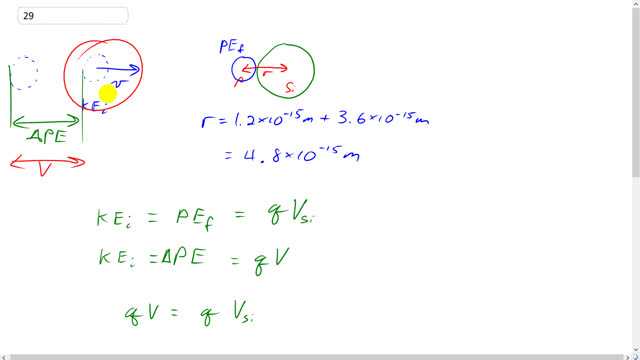
How much voltage must be used to accelerate a proton (radius ) so that it has sufficient energy to just “touch” a silicon nucleus? A silicon nucleus has a charge of +14e, and its radius is about . Assume the potential is that for point charges.

In order to watch this solution you need to have a subscription.
This is Giancoli Answers with Mr. Dychko. So some proton is starting here at rest and it's getting accelerated through some potential difference here so that by the time it reaches this point, it has some kinetic energy that will be enough to reach this position here where it just barely touches the silicon nucleus and this kinetic energy that has here is going to be equal to the loss in potential energy that it had going from here to here. So this change in potential energy is the charge q times this voltage V and the kinetic energy that it needs here, we'll call that kinetic energy initial is going to equal the final potential energy that it has at this position here. Just touching this silicon nucleus. So there's two kinds of conservation of energy things happening here. One is this potential energy as here is going to get turned into kinetic energy here and then this kinetic energy here is going to get turned into potential energy here. So the potential energy that it has at this point is q times the potential due to the silicon nucleus. And since both of these equal the kinetic energy at this position here, we can say that they're equal to each other as we do on this line. And so we can cancel the q on both sides and that means the potential that we need to accelerate the proton is the potential due to the point charge of the silicon nucleus and it has a charge of 14 times the elementary charge multiplied by coulomb’s constant divided by the radius of the silicon nucleus and we get 8.988 times ten to the 9 newton meter squared per coulomb squared times 14 times 1.6 into ten to the minus 19 coulombs divided by the radius of the silicon nucleus, 4.8 ten to the minus 15 meters And sorry this number here is not the radius of the silicon nucleus actually the distance between the center of the silicon nucleus and the center of the proton so the proton has has a radius of this much and 1.2 times ten to the minus 15 meters. So the distance between the center of the proton and the center of the silicon, this is the distance we're concerned with in our potential formula. This potential formula here, potential due to the silicon nucleus. The center of the proton gets to this distance 4.8 times 10 to the minus 15 meters, center of proton to center of nucleus, silicon nucleus so add those two radii together and that's what this number is here. And so we end up with 4.2 times ten to the six volts is the potential required for accelerating the proton initially such that it can reach this position here.